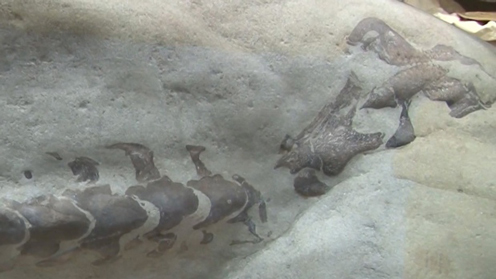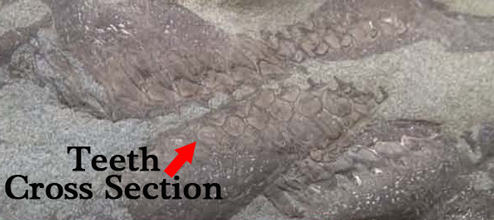A Fishy Dinosaur Tail from South-western Alberta
Fishermen Spot Duck-Billed Dinosaur Fossil in the Castle River
Palaeontologists at the Royal Tyrrell Museum (Alberta, Canada), have a new hadrosaur specimen to study, thanks to a pair of keen-eyed fishermen who spotted the fossilised remains of an 80-million-year-old dinosaur whilst on an angling trip to the Castle River in the extreme south-west of Alberta.
Hadrosaur Specimen
Back in August, a father and son fishing trip on the river was interrupted when the son, spotted the brownish/black outline of some bones exposed on the surface of a huge boulder that had been washed into the middle of the Castle River. Last year, the south-west of Alberta experienced some of the worst flooding in living memory.
The devastation caused by the extensive flooding had a silver lining for vertebrate palaeontologists as a number of fossils were swept into river systems. This hadrosaur specimen, which consists of a partial skull, articulated cervical vertebrae and bones from the upper portion of the chest, could represent an entirely new species.
The Fossilised Bones are Entombed Inside a Sandstone Boulder
Picture credit: Royal Tyrrell Museum
Hadrosaurs
Hadrosaurs, or more specifically dinosaurs that belong to the Superfamily known as the Hadrosauroidea, were bird-hipped, herbivores that had horny beaks and batteries of teeth to help them cope with tough vegetation. Known from the Cretaceous to the very end of the Age of Dinosaurs, these reptiles, also referred to as the duck-billed dinosaurs were amongst the most speciose of all the known types of dinosaur and they were particularly numerous and diverse during the Campanian and Maastrichtian faunal stages of Late Cretaceous North America.
Commenting on the significance of this discovery, the Curator of Dinosaurs at the Royal Tyrrell Museum, Dr Donald Henderson explained that the unusual location of this fossil find, just a few miles from the border with British Columbia, makes this specimen extremely important.
He stated:
“It is one of the reasons we were so keen to get it, every time we find something different in another part of the province, it’s something important. This means we could be finding new dinosaurs in the extreme south-west of Alberta.”
Duck-billed Dinosaur Fossil
A helicopter was called in to airlift the one tonne boulder onto a low-loader for transport up to Drumheller, where the museum is based. The specimen will then be carefully prepared in the museum’s laboratory. Field workers did search the rest of the river bed and along the banks in the immediate vicinity of the fossil in a bid to find other parts of the skeleton, but to no avail. Last year’s floods may have delivered this partial specimen but the remainder would have most likely been washed away.
It is rare for such a specimen, to be preserved in this manner. The sandstone rock in which the fossil is entombed is extremely hard, the resistance of this rock to erosion helped preserve the fossil, although extracting the fossilised bones from the surrounding matrix will be a very difficult and time consuming job due to the tough matrix.
Entombed in Hard Sandstone
Dr Henderson added:
“It’s in really, really hard sandstone, otherwise it would have been smashed up a long time ago. It’s [the fossil specimen] sort of coiled up inside, at the time of its death, the neck and head curled back and the body was swept away in a river of sand. “
A Close up of the Skull Showing the Rows of Teeth in the Jaws
Picture credit: Royal Tyrrell Museum
A spokesperson from Everything Dinosaur said, that the actions of the fishermen should be praised. It is important for members of the public to alert museums when they come across something unexpected and unusual. The fossil is probably preserved in three-dimensions, the hard sandstone protecting the bones, normally such bones are crushed, flattened and smashed. Palaeontologists might be able to learn a great deal about Late Cretaceous ornithischian dinosaurs as a result of this fossil discovery.



